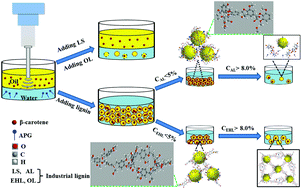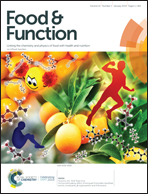Development of anti-photo and anti-thermal high internal phase emulsions stabilized by biomass lignin as a nutraceutical delivery system†
Abstract
Herein, oil-in-water high internal phase emulsions (HIPEs) were stabilized by lignin from different technical resources with the assistance of alkyl polyglycoside (APG) using an ultrasonic cavitation method. The results showed that the amphiphilicity of lignin determined the formation of HIPEs. Microscopic and rheological characterization indicated that the molecular weight and concentration of lignin, the APG dosage and the oil/water ratio had important influences on the microstructure and stability of the HIPEs. In addition, nutraceutical β-carotene could be encapsulated in the oil phase of the HIPEs, which exhibited outstanding protection against photo- and thermal-oxidative degradation of β-carotene. After storage for 30 days under room temperature/light or storage for 7 days under 55 °C/dark conditions, the retention of β-carotene in the HIPEs was 87% to 95%, which is significantly higher than that of β-carotene dispersed in bulk oil. In vitro digestion experiments indicated that the digestibility of the HIPEs also markedly improved. The largest release of free fatty acids was 80%. The bio-accessibility of β-carotene in these lignin-based HIPEs also reached 60%.



 Please wait while we load your content...
Please wait while we load your content...